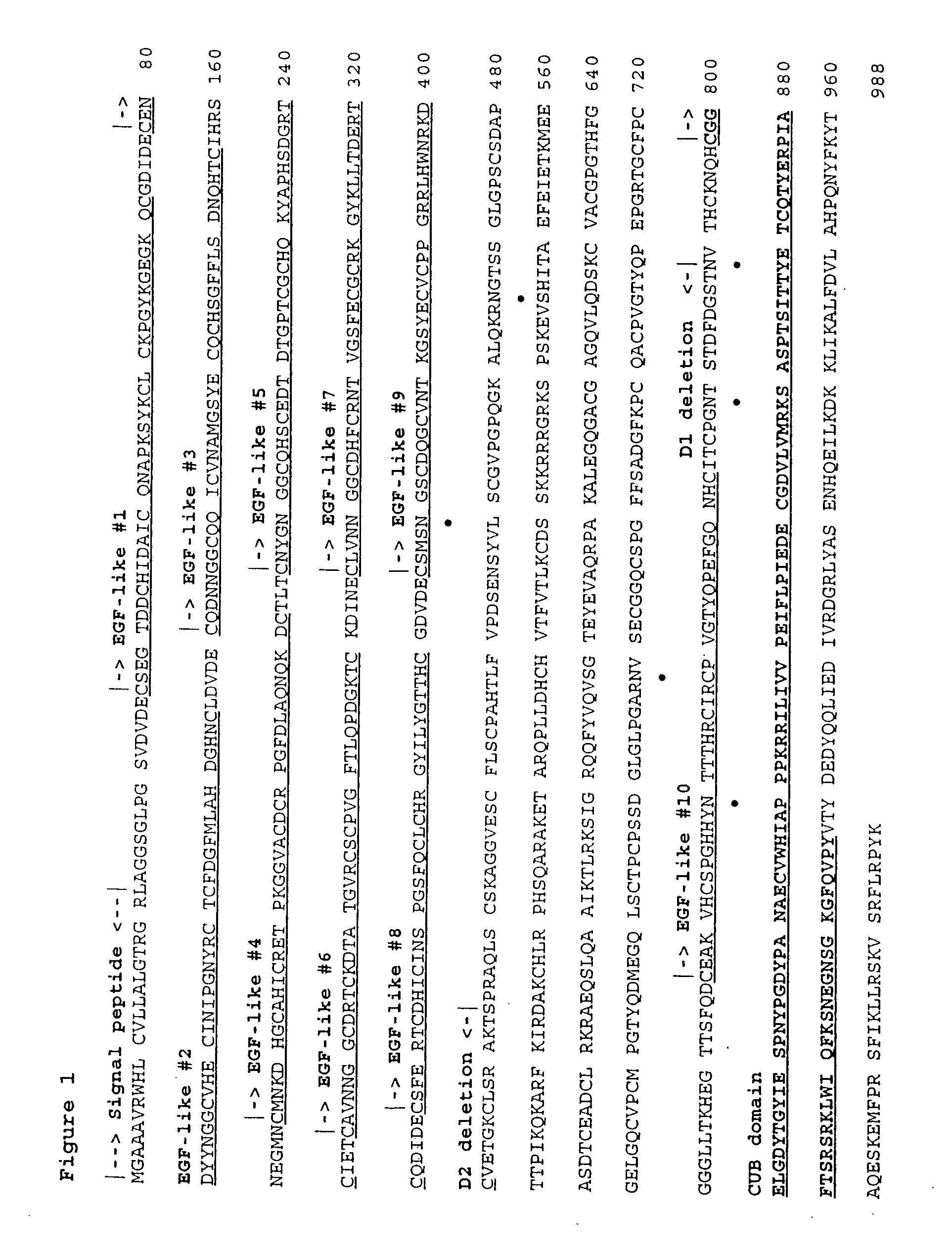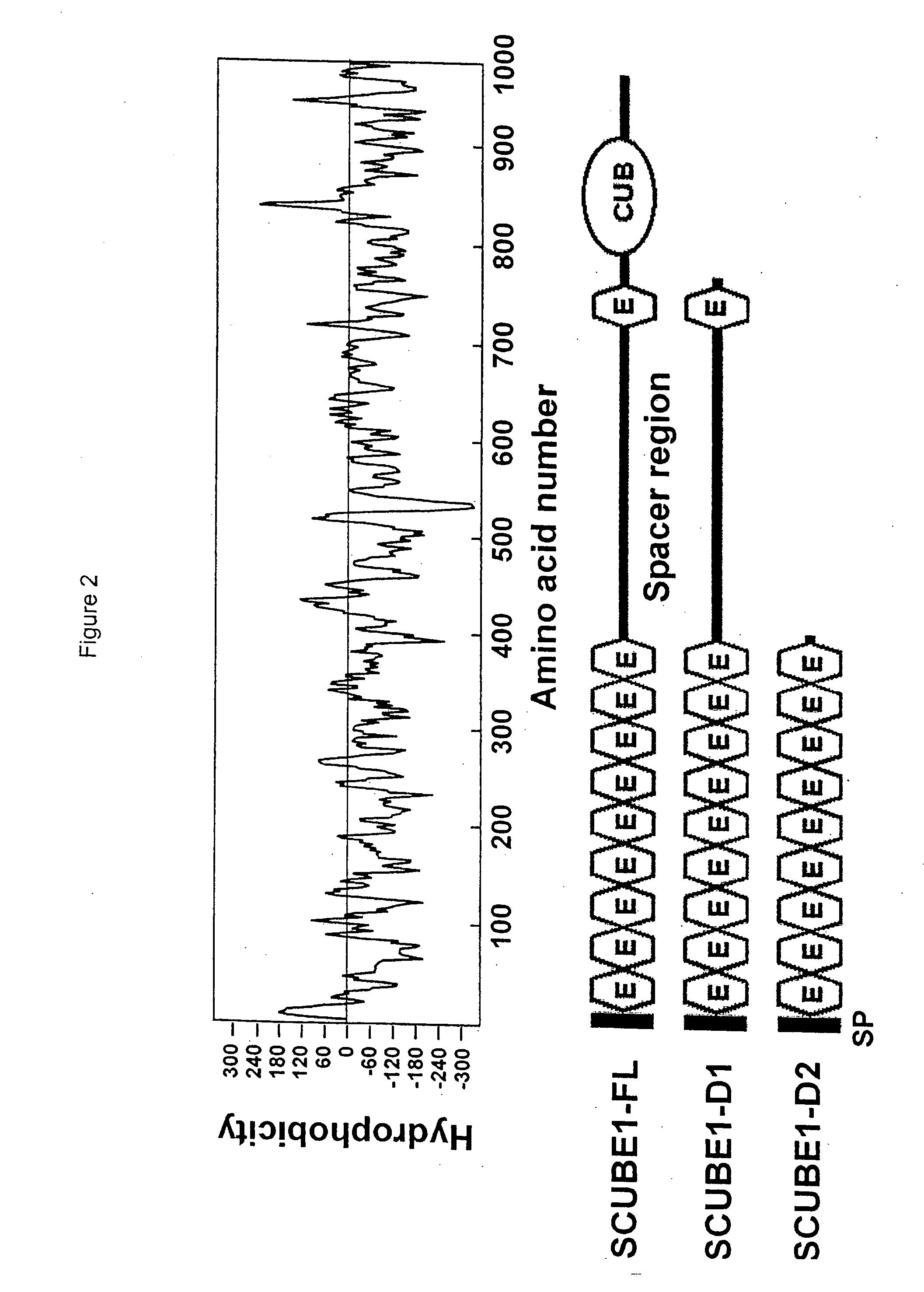Identification of a family of secreted proteins in vascular endothelium
a technology of secreted proteins and vascular endothelium, which is applied in the direction of peptides, drug compositions, cardiovascular disorders, etc., can solve the problems of thrombotic complications, a major cause of death,
- Summary
- Abstract
- Description
- Claims
- Application Information
AI Technical Summary
Benefits of technology
Problems solved by technology
Method used
Image
Examples
example 1
f SCUBE1 and SCUBE2
[0216] The SCUBE1 gene was found to reside on human chromosome 22q13 and is comprised of multiple exons. Cloning and sequencing of the SCUBE1 gene was accomplished by screening a mixed tissue human cDNA library. A pair of primers flanking the ORF of SCUBE1 were used in standard PCR amplification techniques. The resultant PCR product was cloned into pcDNA3.1 and sequenced to confirm that a full-length clone of SCUBE1 had been obtained.
[0217] The SCUBE1 nucleic acid sequence is disclosed herein as SEQ ID NO: 1. SCUBE1 is 2992 nucleotides in length and has an open reading frame encoding a protein of 988 amino acids (SEQ ID NO: 2). The ORF spans nucleotides 21-2987 (21-2984 without the TAA stop codon) of SEQ ID NO: 1. A signal peptide is found at amino acids 1-22 of SEQ ID NO: 2 (FIG. 1), and 10 EGF-like domains are found at amino acids 37-72; 78-115; 121-156; 166-202; 206-241; 245-280; 286-321; 327-360; 366-401; and 737-773. A CUB domain is located at amino acids 79...
example 2
A Expression in Vascular Endothelium
[0223] SCUBE cDNA, or portions or fragments thereof, can be used to detect the presence of SCUBE mRNA in human tissues, as well as to probe for SCUBE-related gene products in other species.
[0224] Differential expression of SCUBE in human tissues was determined using by Northern blotting and by RT-PCR.
[0225] The tissue distribution of RNA encoding the protein of SEQ ID NO: 2 was analyzed by Northern blot (FIG. 5), as well as by RT-PCR expression analysis (FIG. 9). For Northern blotting, RNA was isolated from the following human tissues using standard protocols: human brain, heart, skeletal muscle, colon, thymus, spleen, kidney, liver, small intestine, placenta, lung and peripheral blood lymphocytes. Northern blots were prepared using a probe derived from SEQ ID NO: 1, with hybridization conditions as described by Sambrook et al. Expression of SCUBE1 is strong in the liver, kidney, lung, and small intestine.
[0226] RT-PCR expression analysis was a...
example 3
a Secreted Protein
[0228] As predicted by the signal sequence and EGF-like motifs, the SCUBE1 protein is secreted (see FIG. 3). HEK-293 cells were transfected with the expression vector encoding Myc-tagged human SCUBE1 at the C-terminus (SCUBE1.Myc) and the endogenous signal peptide. Forty-eight hours after transfection, conditioned medium was collected and cells were detached with PBS. Extracellular matrix on the culture dish was extracted with Laemmli sample buffer. Samples from conditioned culture medium (Medium), cell lysates (Cell) and the extracellular matrix (Matrix) were separated by 4-20% SDS-polyacrylamide gel electrophoresis and transferred to PVDF membranes. Recombinant SCUBE1 proteins were detected in the culture medium and in the cell lysate by Western blotting with anti-Myc antibody (FIG. 3a).
[0229] HEK-293 cells were also transfected with the expression vector encoding both Flag- and Myc-tagged SCUBE1 at the N- and C-termini (Flag.SCUBE1.Myc). Two days after transfec...
PUM
| Property | Measurement | Unit |
|---|---|---|
| thickness | aaaaa | aaaaa |
| dry weight | aaaaa | aaaaa |
| dry weight | aaaaa | aaaaa |
Abstract
Description
Claims
Application Information
 Login to View More
Login to View More - R&D
- Intellectual Property
- Life Sciences
- Materials
- Tech Scout
- Unparalleled Data Quality
- Higher Quality Content
- 60% Fewer Hallucinations
Browse by: Latest US Patents, China's latest patents, Technical Efficacy Thesaurus, Application Domain, Technology Topic, Popular Technical Reports.
© 2025 PatSnap. All rights reserved.Legal|Privacy policy|Modern Slavery Act Transparency Statement|Sitemap|About US| Contact US: help@patsnap.com



